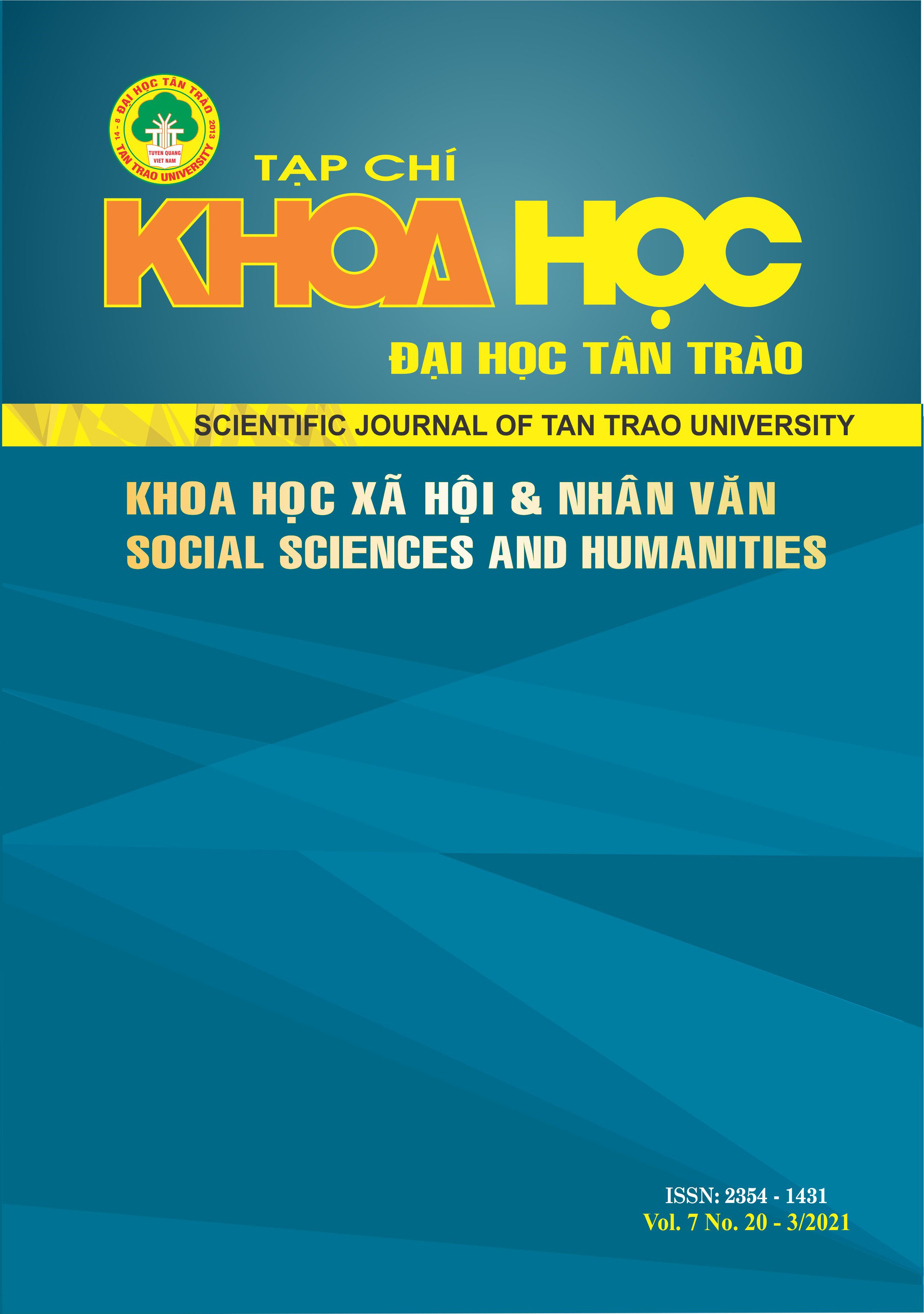GENRES, RHYMES AND RHYTHMS IN LUON, QUAN LANG AND THEN SINGING OF TAY ETHNIC MINORITY
DOI:
https://doi.org/10.51453/2354-1431/2021/486Keywords:
Folk music, Tay ethnic minority, luon singing, quan lang singing, then singing.Abstract
From the linguistic perspective, the article studies the characteristics of genres, rhymes, and rhythms of the Tay folk songs through linguistic material of luon, quan lang and then singing. There are two genres, namely the 7-tone form and the mixed one. The most dominant is the 7-tone form, which is used mainly in the call-and-response performance of luon and quan lang singing. The mixed form is widely used in then singing. Internal rhymes are found frequently in both of 7-tone and mixed forms; there is rarely end rhymes which are only met in a few lyrics of luon singing. The rhythm of Tay folk music is rich with typical vocal breaks. There are both semantic rhythm and phonetic rhythm, with both even and odd beats. Even rhythms are found in the sentences with even numbers of tones, usually including 2-2; 2-2-2; 4-4, 2-2-2-2… and odd rhythms exist in the sentences with odd numbers of tones, usually including 3-4, 3-2-2; 3-2 ...
The research results show that there is insignificant difference among luon, quan lang and then singing; the main difference is between then singing and quan lang, luon singing in terms of genre. This is the typical characteristic of the kind of "speak-singing" (also called "narrative singing").
Downloads
References
[1] An, T. (editor). (2000). Then Tay songs, National Culture Publishing House, Hanoi.
[2] Ban, D.Q. (2010). Linguistics Dictionary, Education Publishing House, Hanoi.
[3] Bac, N.D. (2001). Folk Poetry in Lang Son, National Cultural Publishing House, Hanoi.
[4] Canh, N.P. (2001). Poetic Language, Literature Publishing House, Hanoi.
[5] Cu, H.T. (2018). Luon, phong slu, lyrical folk music of the Tay people in Lang Son, Writers Association Publishing House, Hanoi.
[6] Hanh, L.T. (2020). Wedding customs of the Tay people in Bac Kan, Thai Nguyen University Publishing House, Thai Nguyen.
[7] Hoa, N.T. (2005). Dictionary of rhetoric - style, poetics, Education Publishing House, Hanoi.
[8] Hong, N.Q., Phuong, P.D. (2017). Vietnamese syllables and poetic language, National University Publishing House, Hanoi.
[9] Hong, V. (1979). Sli, luon, Tay - Nung lyrical folk music, Cultural Publishing House, Hanoi.
[10] Mai, T.T. (2012). Tay - Nung folklore in Cao Bang, Labor Publishing House, Hanoi.
[11] Nhinh, N.T. (2000). Folk Music of Tay, Nung, Dao people in Lang Son, Ethnic Culture Publishing House, Hanoi.
[12] Phuong, N.H., Vu, P.V. (Co-editor) (2016). Some types of ethnic minority folk arts in the Northern mountainous area, Thai Nguyen University Publishing House, Thai Nguyen.
[13] Thang, L.T. (2015). Rules of “Lục bát” poems in The Tale of Kiều, Vietnam Education Publishing House, Hanoi.
[14] Thong, T.V., Tung, T.Q. (2017). Languages of ethnic groups in Vietnam, Thai Nguyen University Publishing House, Thai Nguyen.
[15] Tu, N.T. (2008). Quan lang poetry, National Culture Publishing House, Hanoi.
[16] Yen, N.T. (2006). Then Tay, Social Science Publishing House, Hanoi.
Downloads
Published
How to Cite
Issue
Section
License

This work is licensed under a Creative Commons Attribution-ShareAlike 4.0 International License.
All articles published in SJTTU are licensed under a Creative Commons Attribution-ShareAlike 4.0 International (CC BY-SA) license. This means anyone is free to copy, transform, or redistribute articles for any lawful purpose in any medium, provided they give appropriate attribution to the original author(s) and SJTTU, link to the license, indicate if changes were made, and redistribute any derivative work under the same license.
Copyright on articles is retained by the respective author(s), without restrictions. A non-exclusive license is granted to SJTTU to publish the article and identify itself as its original publisher, along with the commercial right to include the article in a hardcopy issue for sale to libraries and individuals.
Although the conditions of the CC BY-SA license don't apply to authors (as the copyright holder of your article, you have no restrictions on your rights), by submitting to SJTTU, authors recognize the rights of readers, and must grant any third party the right to use their article to the extent provided by the license.


